

Marzano's Instructional Strategies. Identifying Similarities and Differences. Related Classroom Examples Imagining Change Images help set the stage for understanding abstract concepts. Magnifying Learning Young English language learners talk about the world using hand lenses. Learning Categories Sixth-graders reflect on and categorize traits of successful learners. Identifying Similarities and Differences Seeing similarities and differences is a fundamental cognitive process (Gentner & Markman, 1994; Medin, Goldstone, & Markman, 1995). Key Research Findings Cognitive research shows that educational programs should challenge students to link, connect, and integrate ideas (Bransford, Brown, & Cocking, 1999). Implementation Students benefit by direct instruction and open-ended experiences in identifying similarities and differences.
Additional Resources The Private Eye is a resource for teaching students how to use metaphor, and compare and contrast, through the use of jeweler's loupes and focused questioning. Researched-Based Strategies. Related Classroom Examples Exhibiting Effort Students exhibit learning at a high school science fair for the community.

Projecting Success Digital cameras increase student self-concept as high achievers. Reinforcing Effort Although research on learning tends to focus on instructional strategies related to subject matter, students' beliefs and attitudes have a significant effect on their success or failure in school. Key Research Findings Not all students know the connection between effort and achievement (Seligman, 1990, 1994; Urdan, Migley, & Anderman, 1998).
Implementation Recognizing learning includes specific tactics for improving students' beliefs about their abilities and how and when to recognize them when they achieve. Teach the relationship between effort and achievement. Additional Resources. Nonlinguistic Representation. Related Classroom Examples Choreographing Math.
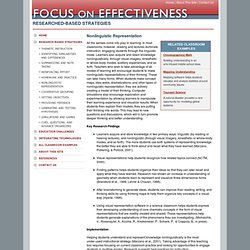
Researched-Based Strategies. Related Classroom Examples Guiding Cooperation Teacher turns to technology to guide cooperative learning in a blended fourth-fifth science class.

Collaborative Writing Middle school students polish skills for writing, reflection, and collaboration. Cooperative Grouping Cooperative learning is actually a generic term that refers to numerous methods for grouping students. Students understand that their membership in a learning group means that they either succeed or fail—together. Key Research Findings Organizing students in heterogeneous cooperative learning groups at least once a week has a significant effect on learning (Marzano, Pickering, & Pollock, 2001).
Implementation Grouping students to work collaboratively and cooperatively offers benefits for learners. Create the right type of group for the need. Additional Resources. Researched-Based Strategies. Related Classroom Examples Owning Goals Creating personal learning goals supports literacy.
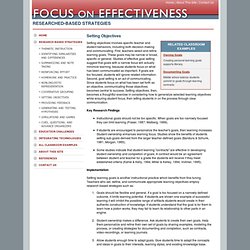
Documenting Goals Middle school science students commit to goals through learning contracts. Setting Objectives. Generating and Testing Hypotheses. Related Classroom Examples Investigating Hypotheses Applying the scientific method high school students use technology to help frame science investigations.
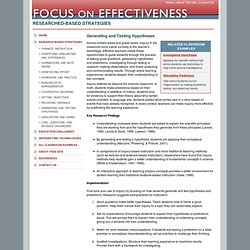
Stimulating Predictions High school students correct misperception by making predictions, testing, and observing results. Generating and Testing Hypotheses Across content areas and grade levels, inquiry in the classroom turns native curiosity to the learner's advantage. Inquiry extends far beyond the science classroom. Key Research Findings Understanding increases when students are asked to explain the scientific principles they are working from and the hypotheses they generate from these principles (Lavoie, 1999; Lavoie & Good, 1988; Lawson, 1988).
Implementation Fine-tune your use of inquiry by focusing on how students generate and test hypotheses and predictions. Good questions make better hypotheses. Additional Resources The Northwest Regional Educational Laboratory provides a Web resource on the Science Inquiry Model. Researched-Based Strategies. Related Classroom Examples Messaging Shakespeare Summarizing complex texts using cell phones increases understanding.
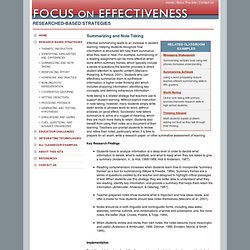
Summarizing Software Using a word processing feature teaches efficient summarizing skills to fifth-graders. Worth Noting Online note taking with primary sources improves research skills in high school students. Cues, Questions, and Advance Organizers. Related Classroom Examples Charting The News High school students use Web-based news services to view, explore, and chart current events.
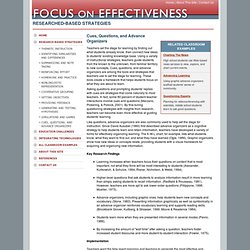
Advancing Learning Using graphic advance organizers scaffold students' sense of community. Questioning Experts Planning for videoconferencing with scientists, middle school students learn to ask good questions. Cues, Questions, and Advance Organizers Teachers set the stage for learning by finding out what students already know, then connect new ideas to students' existing knowledge base. Asking questions and prompting students' replies with cues are strategies that come naturally to most teachers. Researched-Based Strategies. Related Classroom Examples Revolutionizing Chat Using Internet relay chat to focus practice while studying the French Revolution.
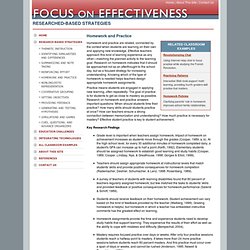
Practicing Patterns Interactive Web tools support math learning, providing fourth-graders skill practice that matters.